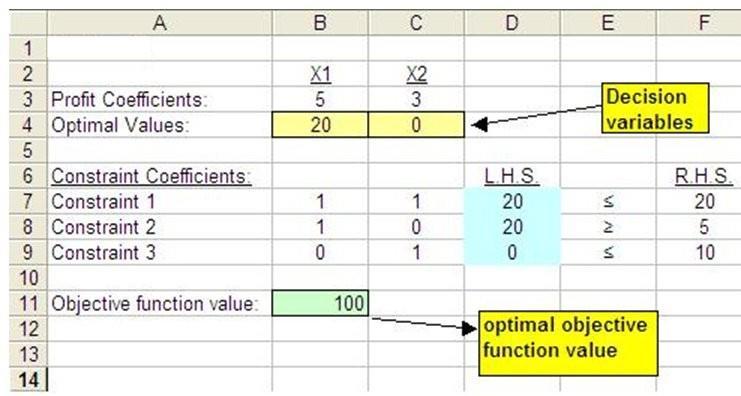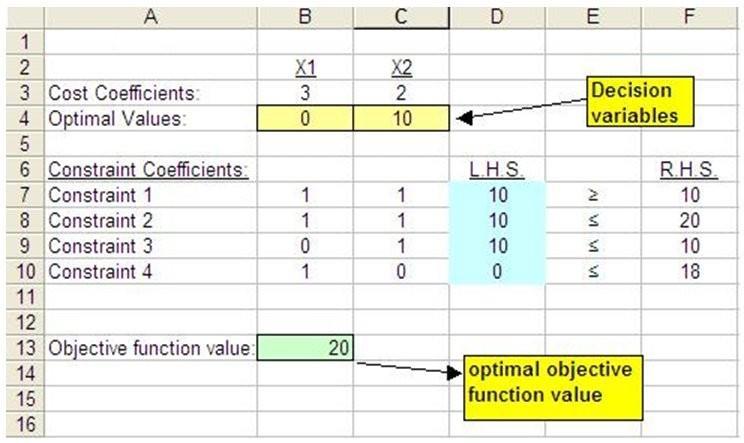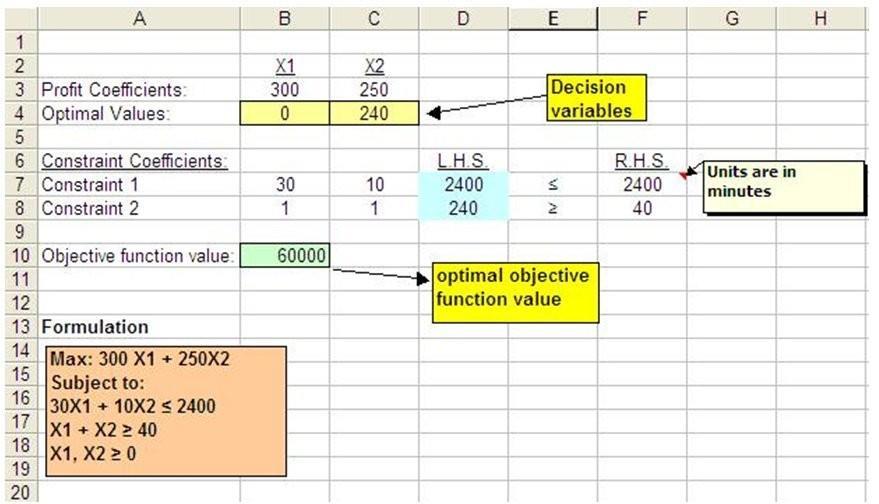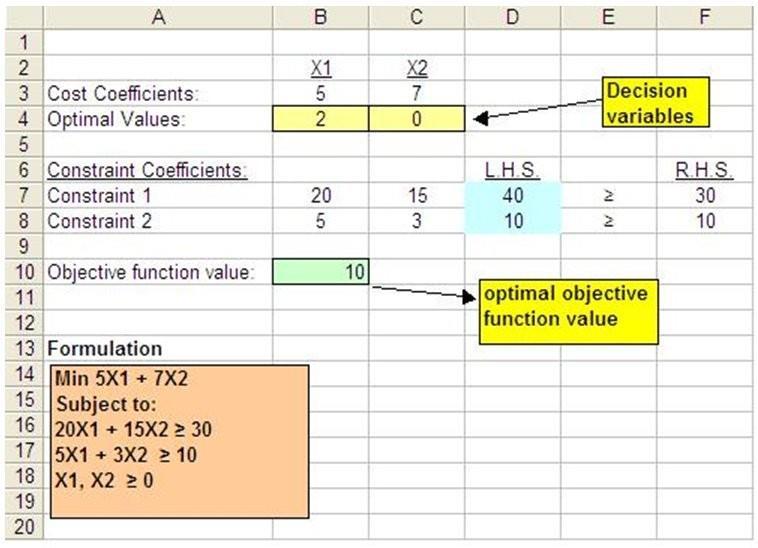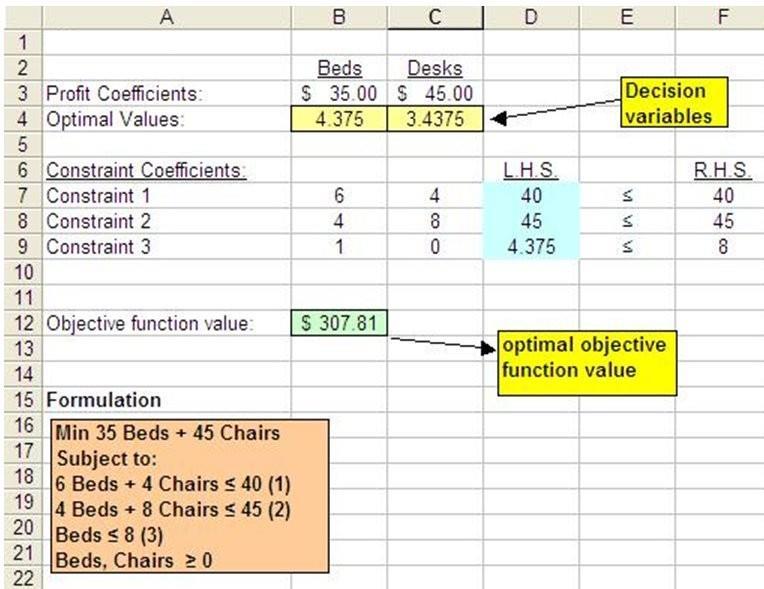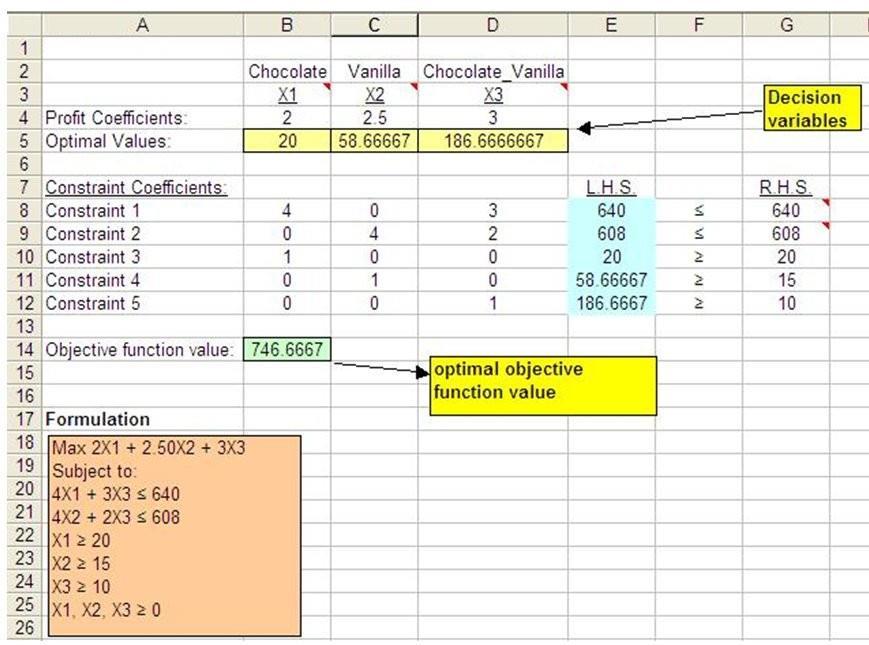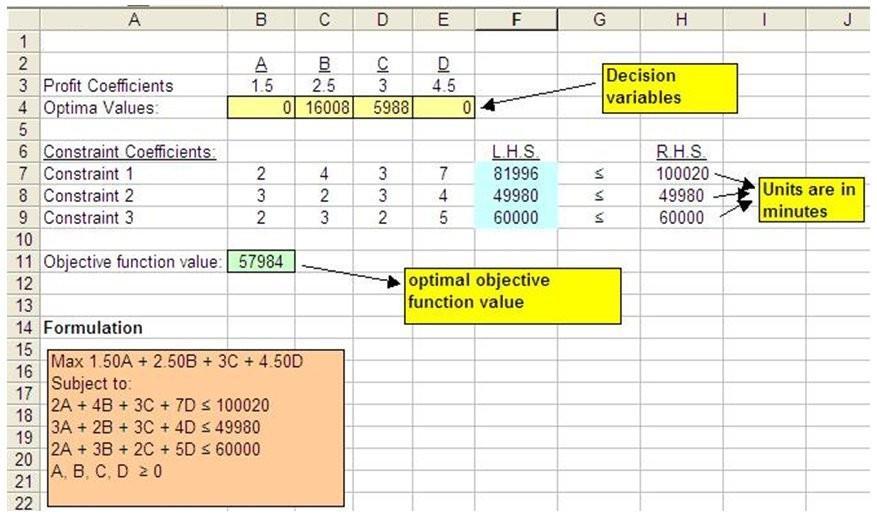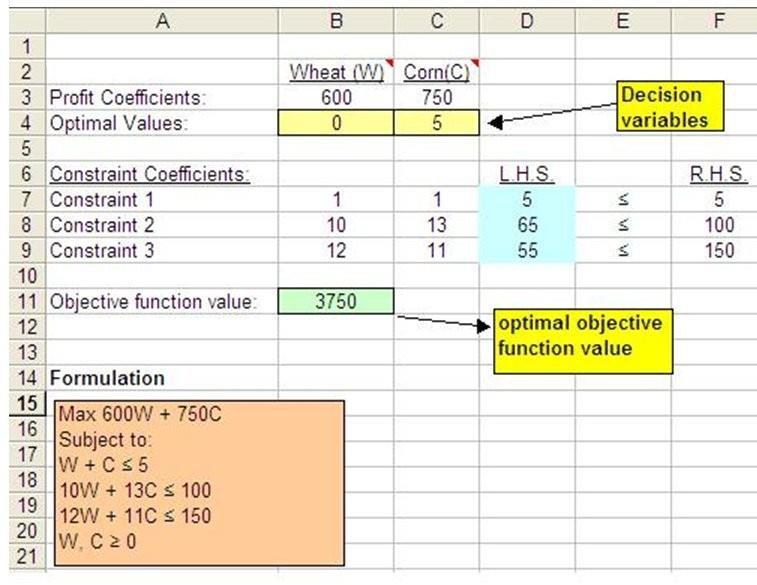Managerial Decision Modeling w/ Spreadsheets, 3e (Balakrishnan/Render/Stair)
Chapter 2 Linear Programming Models: Graphical and Computer Methods
2.1 Chapter Questions
1) Consider the following linear programming model:
Max X12 + X2 + 3X3
Subject to: X1 + X2 ≤ 3
X1 + X2 ≤ 1
X1, X2 ≥ 0
This problem violates which of the following assumptions?
A) certainty
B) proportionality
C) divisibility
D) linearity
E) integrality
Answer: D
Page Ref: 22
Topic: Developing a Linear Programming Model
Difficulty: Easy
2) Consider the following linear programming model:
Min 2X1 + 3X2
Subject to: X1 + 2X2 ≤ 1 X2 ≤ 1
X1 ≥ 0, X2 ≤ 0
This problem violates which of the following assumptions?
A) additivity
B) divisibility
C) non-negativity
D) proportionality
E) linearity
Answer: C
Page Ref: 21
Topic: Developing a Linear Programming Model
Difficulty: Easy
Copyright (c) 2013 Pearson Education, Inc. publishing as Prentice Hall
3) A redundant constraint is eliminated from a linear programming model. What effect will this have on the optimal solution?
A) feasible region will decrease in size
B) feasible region will increase in size
C) a decrease in objective function value
D) an increase in objective function value
E) no change
Answer: E
Page Ref: 36
Topic: Special Situations in Solving Linear Programming Problems
Difficulty: Moderate
4) Consider the following linear programming model:
Max 2X1 + 3X2
Subject to:
X1 ≤ 2
X2 ≤ 3
X1 ≤ 1
X1, X2 ≥ 0
This linear programming model has:
A) alternate optimal solutions
B) unbounded solution
C) redundant constraint
D) infeasible solution
E) non-negative solution
Answer: C
Page Ref: 36
Topic: Special Situations in Solving Linear Programming Problems
Difficulty: Moderate
5) A linear programming model generates an optimal solution with fractional values. This solution satisfies which basic linear programming assumption?
A) certainty
B) divisibility
C) proportionality
D) linearity
E) non-negativity
Answer: B
Page Ref: 22
Topic: Developing a Linear Programming Model
Difficulty: Moderate
Copyright (c) 2013 Pearson Education, Inc. publishing as Prentice Hall
6) Consider the following linear programming model:
Max X1 + X2
Subject to:
X1 + X2 ≤ 2
X1 ≥ 1
X2 ≥ 3
X1, X2 ≥ 0
This linear programming model has:
A) alternate optimal solution
B) unbounded solution
C) redundant constraint
D) infeasible solution
E) unique solution
Answer: D
Page Ref: 37
Topic: Special Situations in Solving Linear Programming Problems
Difficulty: Easy
7) Consider the following linear programming model
Max 2X1 + 3X2
Subject to:
X1 + X2
X1 ≥ 2
X1, X2 0
This linear programming model has:
A) redundant constraints
B) infeasible solution
C) alternate optimal solution
D) unique solution
E) unbounded solution
Answer: E
Page Ref: 39
Topic: Special Situations in Solving Linear Programming Problems
Difficulty: Easy
Copyright (c) 2013 Pearson Education, Inc. publishing as Prentice Hall
8) Consider the following linear programming model
Min 2X1 + 3X2
Subject to:
X1 + X2 ≥ 4
X1 ≥ 2 X1, X2 0
This linear programming model has:
A) unique optimal solution
B) unbounded solution
C) infeasible solution
D) alternate optimal solution
E) redundant constraints
Answer: A
Page Ref: 38
Topic: Special Situations in Solving Linear Programming Problems
Difficulty: Easy
Copyright (c) 2013 Pearson Education, Inc. publishing as Prentice Hall
Figure 1 demonstrates an Excel spreadsheet that is used to model the following linear programming problem:
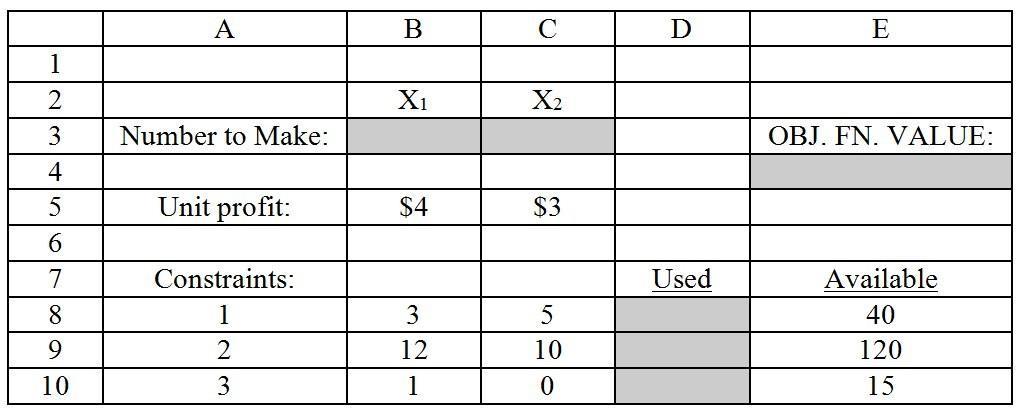
Max: 4 X1 + 3 X2
Subject to:
3 X1 +5 X2 ≤ 40
12 X1 + 10 X2 ≤ 120
X1 ≥ 15
X1, X2 ≥ 0
Note: Cells B3 and C3 are the designated cells for the optimal values of X1 and X2, respectively, while cell E4 is the designated cell for the objective function value. Cells D8:D10 designate the left-hand side of the constraints.
9) Refer to Figure 1. What formula should be entered in cell E4 to compute total profitability?
A) =SUMPRODUCT(B5:C5,B2:C2)
B) =SUM(B3:C3)
C) =B2*B5 + C2*C5
D) =SUMPRODUCT(B5:C5,E8:E10)
E) =B3*B5 + C3*C5
Answer: E
Page Ref: 42
Topic: Setting Up and Solving Linear Programming Problems Using Excel's Solver
Difficulty: Easy
10) Refer to Figure 1. What formula should be entered in cell D9 to compute the amount of resource 2 that is consumed?
A) =B9*D9 + C9*D9
B) =SUMPRODUCT(B2:C2,B9:C9)
C) =SUM(B9:C9)
D) =SUMPRODUCT(B3:C3,B9:C9)
E) =SUMPRODUCT(B9:C9,B5:C5)
Answer: D
Page Ref: 42
Topic: Setting Up and Solving Linear Programming Problems Using Excel's Solver
Difficulty: Easy
11) Refer to Figure 1. Which cell(s) are the Changing Cells as designated by "Solver"?
A) E4
B) B2:C2
C) B3:C3
D) D8:D10
E) B5:C5
Answer: C
Page Ref: 42
Topic: Setting Up and Solving Linear Programming Problems Using Excel's Solver
Difficulty: Easy
12) Refer to Figure 1. What cell reference designates the Target Cell in "Solver"?
A) E4
B) B3
C) C3
D) D8:D10
E) E8:E10
Answer: A
Page Ref: 42
Topic: Setting Up and Solving Linear Programming Problems Using Excel's Solver
Difficulty: Easy
13) The constraint for a given resource is given by the following equation: 2X1 + 3X2 ≤ 20
If X1 = 5 and X2 = 3, how many units of this resource are unused?
A) 20
B) 19
C) 1
D) 0
E) 17
Answer: C
Page Ref: 49
Topic: Setting Up and Solving Linear Programming Problems Using Excel's Solver
Difficulty: Easy
14) The constraint for a given resource is given by the following equation: 2X1 + 3X2 ≥ 20
If X1 = 5 and X2 = 4 how many units of this resource are unused?
A) 20
B) 2
C) 22
D) 0
E) 9
Answer: B
Page Ref: 49
Topic: Setting Up and Solving Linear Programming Problems Using Excel's Solver
Difficulty: Easy
Copyright (c) 2013 Pearson Education, Inc. publishing as Prentice Hall
15) "Solver" typically generates which of the following report(s)?
A) answer report
B) sensitivity analysis report
C) limits report
D) A and B only
E) A, B, and C
Answer: E
Page Ref: 48
Topic: Setting Up and Solving Linear Programming Problems Using Excel's Solver
Difficulty: Easy
16) ________ systematically examines corner points, using algebraic steps, until an optimal solution is found.
A) The graphical approach
B) The simplex method
C) Karmarkar's method
D) Trial-and-error
E) none of the above
Answer: B
Page Ref: 52
Topic: Algebraic Solution Procedures for Linear Programming Problems
Difficulty: Moderate
17) ________ follows a path of points inside the feasible region to find an optimal solution.
A) The graphical approach
B) The simplex method
C) Karmarkar's method
D) Trial-and-error
E) none of the above
Answer: C
Page Ref: 52
Topic: Algebraic Solution Procedures for Linear Programming Problems
Difficulty: Moderate
18) If a linear programming problem has alternate optimal solutions, then the objective function value will vary according to each alternate optimal point.
Answer: FALSE
Page Ref: 38
Topic: Special Situations in Solving Linear Programming Problems
Difficulty: Moderate
19) Unbounded linear programming problems typically arise as a result of misformulation.
Answer: TRUE
Page Ref: 39
Topic: Special Situations in Solving Linear Programming Problems
Difficulty: Moderate
Copyright (c) 2013 Pearson Education, Inc. publishing as Prentice Hall
20) If an isoprofit line can be moved outward such that the objective function value can be made to reach infinity, then this problem has an unbounded solution.
Answer: TRUE
Page Ref: 39
Topic: Special Situations in Solving Linear Programming Problems
Difficulty: Easy
21) If a redundant constraint is eliminated from a linear programming model, this will have an impact on the optimal solution.
Answer: FALSE
Page Ref: 36
Topic: Special Situations in Solving Linear Programming Problems
Difficulty: Moderate
22) A linear programming model has the following two constraints: X1 ≥ 3 and X1 ≥ 4. This model has a redundant constraint.
Answer: TRUE
Page Ref: 36
Topic: Special Situations in Solving Linear Programming Problems
Difficulty: Easy
23) A linear programming problem has the following two constraints: X1 ≤ 20 and X1 ≥ 25. This problem is infeasible.
Answer: TRUE
Page Ref: 37
Topic: Special Situations in Solving Linear Programming Problems
Difficulty: Easy
24) It is possible to solve graphically a linear programming model with 4 decision variables.
Answer: FALSE
Page Ref: 26
Topic: Graphical Solution to a Linear Programming Model
Difficulty: Moderate
25) An isoprofit line represents a line whereby all profits are the same along the line.
Answer: TRUE
Page Ref: 29
Topic: Graphical Solution to a Linear Programming Model
Difficulty: Easy
26) Linear programming models typically do not have coefficients (i.e., objective function or constraint coefficients) that assume random values.
Answer: TRUE
Page Ref: 22
Topic: Developing a Linear Programming Model
Difficulty: Moderate
Copyright (c) 2013 Pearson Education, Inc. publishing as Prentice Hall
27) It is possible for a linear programming model to yield an optimal solution that has fractional values.
Answer: TRUE
Page Ref: 22
Topic: Developing a Linear Programming Model
Difficulty: Easy
28) A linear programming model has the following objective function:
Max: X12 + 3X2 + 4X3. This model violates a key linear programming model assumption.
Answer: TRUE
Page Ref: 22
Topic: Developing a Linear Programming Model
Difficulty: Easy
29) In a product mix problem, a decision maker has limited availability of weekly labor hours. Labor hours would most likely constitute a decision variable rather than a constraint.
Answer: FALSE
Page Ref: 24
Topic: Formulating a Linear Programming Model
Difficulty: Easy
30) When using Solver, the parameter Changing Cells is typically associated with the objective function.
Answer: FALSE
Page Ref: 45
Topic: Setting Up and Solving Linear Programming Problems Using Excel's Solver
Difficulty: Easy
31) The simplex method is an algebraic solution procedure for a linear programming problem.
Answer: TRUE
Page Ref: 52
Topic: Algebraic Solution Procedures for Linear Programming Problems
Difficulty: Easy
32) Karmarkar's method is synonymous with the corner point method.
Answer: FALSE
Page Ref: 52
Topic: Algebraic Solution Procedures for Linear Programming Problems
Difficulty: Moderate
Copyright (c) 2013 Pearson Education, Inc. publishing as Prentice Hall


